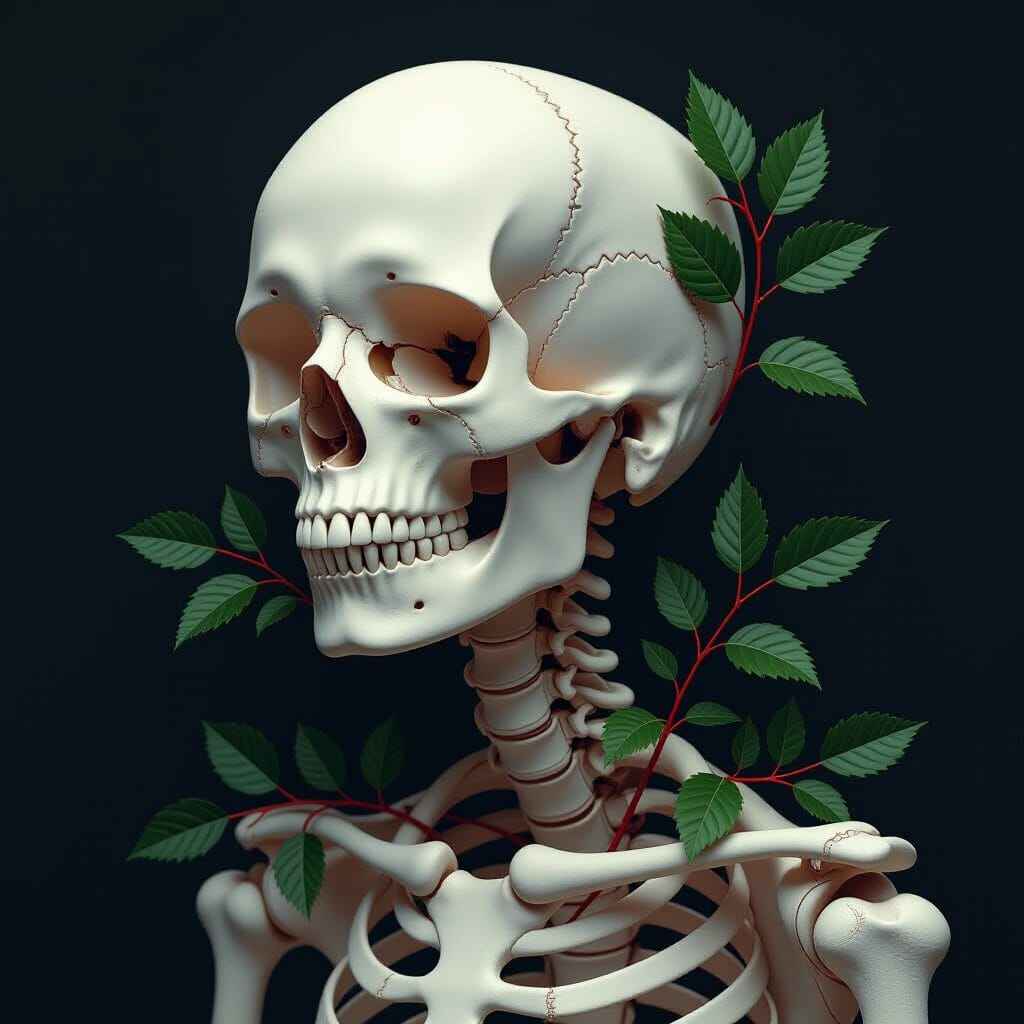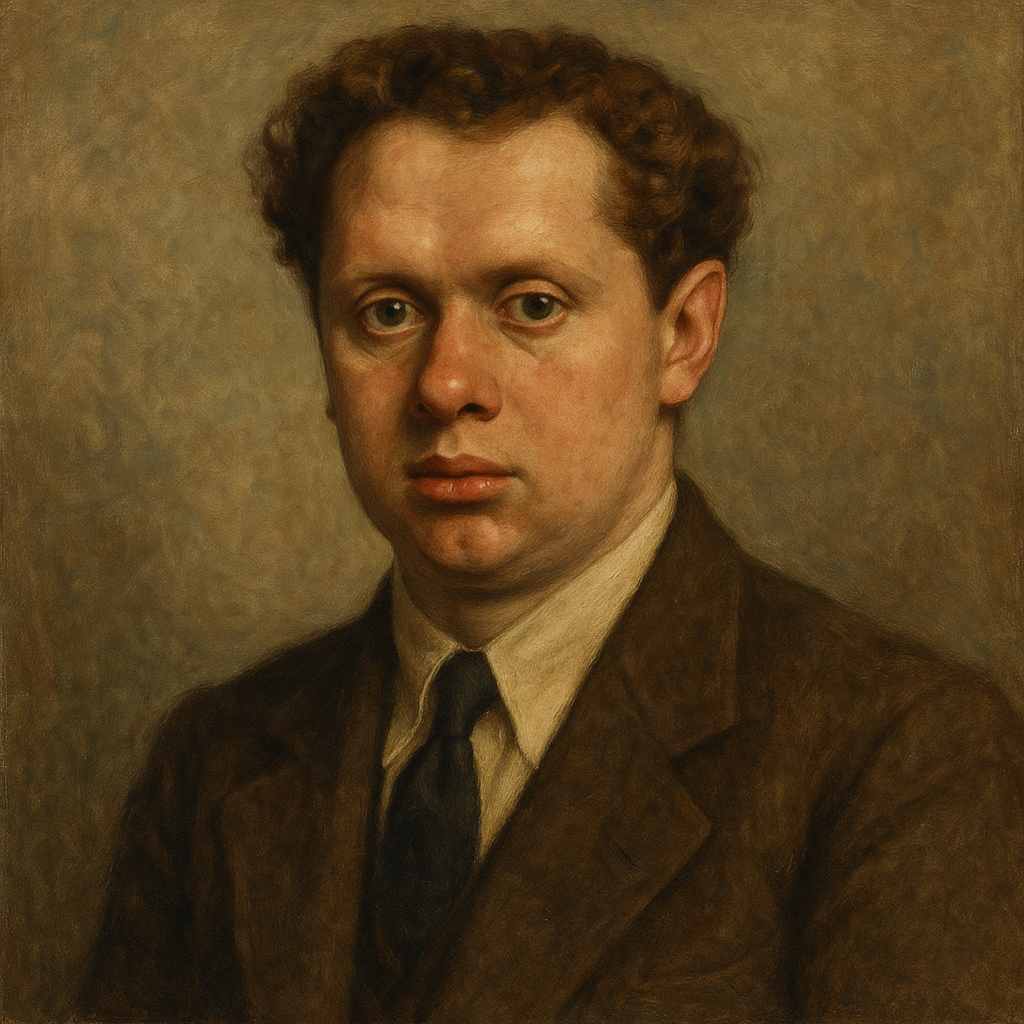Too long, skeleton
Dylan Thomas
1914 to 1953

Too long, skeleton, death’s risen
Out of the soil and seed into the drive,
Chalk cooled by leaves in the hot season,
Too long, skeleton, death’s all alive
From nape to toe, a sanatorium piece
Sly as an adder, rid of fleas.
Take now content, no longer posturing
As raped and reaped, the final emblem.
Thy place is filled, bones bid for auction,
The prism of the eye now void by suction,
New man best whose blood runs thick,
Rather than charnel-house as symbol
Of the moment and the dead hour.
Dylan Thomas's Too long, skeleton
Dylan Thomas’s "Too long, skeleton" is a visceral meditation on mortality, decay, and the inescapable presence of death in life. Written in Thomas’s characteristically dense, image-laden style, the poem grapples with the tension between corporeal dissolution and the persistence of the dead within the living world. The skeletal figure—both a literal corpse and a metaphor for the lingering specter of death—serves as the poem’s central conceit, embodying the grotesque yet inevitable reality of human finitude.
This essay will explore the poem’s historical and cultural context, its use of literary devices, its thematic preoccupations, and its emotional resonance. Additionally, we will consider how Thomas’s personal anxieties about mortality and his Welsh heritage inform the poem’s imagery and tone. A comparative analysis with other works in the memento mori tradition will further illuminate Thomas’s unique contribution to the discourse on death in modernist poetry.
Historical and Cultural Context
Dylan Thomas (1914–1953) wrote during a period of immense upheaval—between the two World Wars and into the early Cold War—when existential dread and the specter of annihilation permeated literature. His work, though not explicitly political, reflects the pervasive anxiety of an era shadowed by war, mechanized slaughter, and the nuclear threat. Unlike the detached irony of high modernists like T.S. Eliot, Thomas’s poetry is fervently embodied, rooted in the physical and the organic, even as it contemplates decay.
Welsh cultural influences also shape the poem. Thomas’s upbringing in Swansea, surrounded by the stark beauty of the Welsh landscape and its folklore, informs his preoccupation with cycles of life and death. The skeleton in the poem is not merely a Gothic prop but a figure drawn from Celtic traditions where the dead remain palpably present—a motif seen in medieval Welsh poetry such as the Cad Goddeu ("The Battle of the Trees"), where bones and vegetation intertwine.
Moreover, the mid-20th century saw a resurgence of interest in the macabre, partly due to Freud’s theories of the uncanny and the trauma of war. Thomas’s skeleton, "death’s risen / Out of the soil and seed into the drive," evokes this cultural moment, where death was no longer a distant abstraction but an immediate, invasive force.
Literary Devices and Imagery
Thomas’s poetry is renowned for its rich, often paradoxical imagery, and "Too long, skeleton" is no exception. The poem employs several key devices to evoke its themes:
1. Paradox and Oxymoron
The poem thrives on contradictions that mirror the uneasy coexistence of life and death. The skeleton is "death’s risen"—an inversion of the resurrection trope, suggesting not revival but death’s active presence. Similarly, "chalk cooled by leaves in the hot season" juxtaposes the cold sterility of bones with the vibrant, living foliage, creating a dissonant yet vivid image.
2. Personification and Animism
Death is not a passive state but an active force: "death’s all alive / From nape to toe." The skeleton is anthropomorphized as "sly as an adder," imbuing it with predatory agency. This technique aligns with Thomas’s broader tendency to animate the inanimate, blurring the line between organic and inorganic matter.
3. Medical and Mortuary Imagery
The skeleton is described as a "sanatorium piece," evoking clinical sterility, while "the prism of the eye now void by suction" suggests an almost surgical removal of life. These images contrast with the natural decay implied in "soil and seed," reinforcing the tension between biological processes and human attempts to medicalize or commodify death ("bones bid for auction").
4. Biblical and Mythological Allusions
The phrase "raped and reaped" invokes both sexual violence and the harvest, evoking the Biblical "reaping" of souls (Revelation 14:15) while also suggesting a violation of the body. The skeleton as "the final emblem" recalls medieval danse macabre imagery, where death is the great equalizer.
Themes
1. The Inescapability of Death
The poem’s opening line—"Too long, skeleton"—suggests an overdue confrontation with mortality. Unlike traditional elegies that mourn the dead, Thomas’s poem presents death as an ever-present, almost nagging force. The skeleton is not buried but intrudes into the living world ("into the drive"), refusing to remain subterranean.
2. The Commodification of the Dead
"Bones bid for auction" critiques the way society objectifies death, turning remains into artifacts or symbols. This resonates with modernist critiques of capitalism’s encroachment on even the most sacred aspects of existence. The skeleton is reduced to a "charnel-house as symbol," stripped of its humanity and repurposed as an aesthetic or philosophical concept.
3. Regeneration vs. Stagnation
The poem contrasts the "new man" whose "blood runs thick" with the skeletal relic of the past. This dichotomy suggests a tension between vitality and morbidity, with Thomas seemingly advocating for a turn away from death-obsession ("no longer posturing / As raped and reaped"). Yet the poem’s tone remains ambivalent—does the "new man" truly escape death, or is he merely another future skeleton?
4. The Corporeal and the Ethereal
Thomas frequently explores the body’s materiality, and here, the skeleton is both a physical remnant and a spectral presence. The "prism of the eye now void by suction" implies the loss of vision—both literal and metaphysical—as death erases perception. This aligns with Thomas’s broader fascination with sensory decay, seen in poems like "Do not go gentle into that good night."
Emotional Impact
The poem’s emotional power lies in its unsettling blend of revulsion and fascination. The skeleton is grotesque ("rid of fleas"), yet its persistence commands attention. There is no solace in religious transcendence—only the brute fact of decay. The final lines ("the moment and the dead hour") suggest that death is not a singular event but a perpetual condition, haunting every present instant.
Thomas’s imagery—sharp, visceral, yet strangely lyrical—creates a dissonance that lingers. The reader is left not with catharsis but with a heightened awareness of mortality’s omnipresence.
Comparative Analysis
Thomas’s skeleton can be compared to other literary depictions of death:
-
John Donne’s Death Be Not Proud: Donne’s personified death is a "slave" to fate, whereas Thomas’s death is autonomous, even predatory.
-
T.S. Eliot’s The Waste Land: Both poets depict death as pervasive, but Eliot’s is barren and fragmented, while Thomas’s is lushly corporeal.
-
Sylvia Plath’s Lady Lazarus: Plath’s resurrection imagery is more defiant, whereas Thomas’s skeleton remains inert, a relic rather than a revenant.
Biographical and Philosophical Insights
Thomas’s heavy drinking and early death at 39 suggest a personal grappling with mortality. His father’s lingering illness (D.J. Thomas died of cancer in 1952) may have influenced the poem’s medical imagery. Philosophically, the poem aligns with existentialist thought—death is not meaningful but an absurd, inescapable fact.
Conclusion
"Too long, skeleton" is a masterful exploration of death’s intrusion into life, rendered through Thomas’s signature linguistic density. Its power lies in its refusal to sanitize decay, instead presenting mortality as an ever-present, almost tactile reality. By intertwining the grotesque with the lyrical, Thomas forces the reader to confront the skeleton not as a metaphor but as an undeniable fact—one that, "too long," has been ignored.
In a world still grappling with existential threats, the poem’s urgency remains undiminished. Thomas reminds us that death is not an abstraction but a skeletal hand reaching from the soil, demanding acknowledgment.
This text was generated by AI and is for reference only. Learn more
Want to join the discussion? Reopen or create a unique username to comment. No personal details required!



Comments
A little bleak.